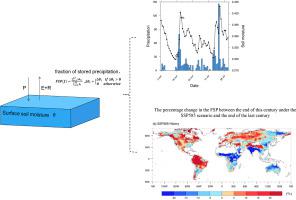Global and Planetary Change ( IF 3.9 ) Pub Date : 2021-08-17 , DOI: 10.1016/j.gloplacha.2021.103616 Xinyue Liu 1 , Xing Yuan 1 , Enda Zhu 2

|
The fraction of stored precipitation (FSP) in surface soil is a new metric to characterize the synoptic-scale dynamics of wet soil moisture anomaly, the impact of which on the atmosphere differs from that of dry anomaly. Investigating the response of FSP to global warming is essential for understanding the land-atmosphere coupling and hydroclimate predictability in a changing climate. Here we use the Coupled Model Intercomparison Project phase 6 (CMIP6) models to project future changes in global FSP under two shared socioeconomic pathway (SSP) scenarios. The historical simulation based on Community Land Model version 5 (CLM5) during 1951–2014 suggests that 14.4% of the global land precipitation is remained in the surface soil within 3 days. The CLM5 simulated FSP applies to validate CMIP6 historical simulations in terms of global mean, spatial correlation and variability, and 5 among 12 CMIP6 models are finally selected to estimate FSP changes in a warming future. Compared with the FSP during the end of 20th century, it increases (decreases) significantly over 29% (16%) of the global land areas after 100 years in the business-as-usual scenario (SSP245). Global warming will increase FSP significantly over Amazon, most of Europe, western USA and Tibet Plateau, while the FSP decreases significantly over India and West Africa due to the increase of precipitation and soil moisture. The changes are more significant in the non-mitigation scenario (SSP585). The projected changes in FSP imply changes in regional flood risk and predictability in a warming future.
中文翻译:

全球变暖导致地表土壤中储存降水的比例发生显着变化
表层土壤中储存降水的比例(FSP)是表征湿土壤水分异常天气尺度动态的新指标,其对大气的影响不同于干异常。研究 FSP 对全球变暖的响应对于理解气候变化中的陆地-大气耦合和水文气候的可预测性至关重要。在这里,我们使用耦合模型比对项目第 6 阶段 (CMIP6) 模型来预测两种共享社会经济路径 (SSP) 情景下全球 FSP 的未来变化。1951-2014 年基于社区土地模型第 5 版 (CLM5) 的历史模拟表明,3 天内全球陆地降水的 14.4% 保留在表层土壤中。CLM5 模拟 FSP 适用于根据全局平均值验证 CMIP6 历史模拟,空间相关性和变异性,最终选择 12 个 CMIP6 模型中的 5 个模型来估计未来变暖的 FSP 变化。与20世纪末的FSP相比,在一切照旧的情景(SSP245)下,100年后全球陆地面积的增加(减少)超过29%(16%)。全球变暖将使亚马逊、欧洲大部分地区、美国西部和青藏高原的 FSP 显着增加,而由于降水和土壤水分的增加,印度和西非的 FSP 显着降低。在非缓解方案 (SSP585) 中,这些变化更为显着。FSP 的预测变化意味着在变暖的未来区域洪水风险和可预测性的变化。与20世纪末的FSP相比,在一切照旧的情景(SSP245)下,100年后全球陆地面积的增加(减少)超过29%(16%)。全球变暖将使亚马逊、欧洲大部分地区、美国西部和青藏高原的 FSP 显着增加,而由于降水和土壤水分的增加,印度和西非的 FSP 显着降低。在非缓解方案 (SSP585) 中,这些变化更为显着。FSP 的预测变化意味着在变暖的未来区域洪水风险和可预测性的变化。与20世纪末的FSP相比,在“一切照旧”情景(SSP245)下,100年后全球陆地面积的增加(减少)超过29%(16%)。全球变暖将使亚马逊、欧洲大部分地区、美国西部和青藏高原的 FSP 显着增加,而由于降水和土壤水分的增加,印度和西非的 FSP 显着降低。在非缓解方案 (SSP585) 中,这些变化更为显着。FSP 的预测变化意味着在变暖的未来区域洪水风险和可预测性的变化。美国西部和青藏高原,而由于降水和土壤湿度的增加,印度和西非的 FSP 显着下降。在非缓解方案 (SSP585) 中,这些变化更为显着。FSP 的预测变化意味着在变暖的未来区域洪水风险和可预测性的变化。美国西部和青藏高原,而由于降水和土壤湿度的增加,印度和西非的 FSP 显着下降。在非缓解方案 (SSP585) 中,这些变化更为显着。FSP 的预测变化意味着在变暖的未来区域洪水风险和可预测性的变化。



























 京公网安备 11010802027423号
京公网安备 11010802027423号